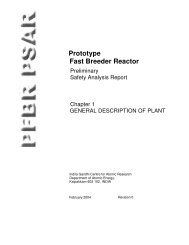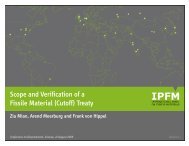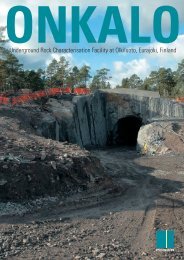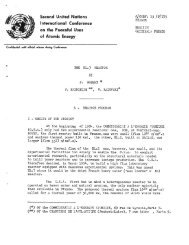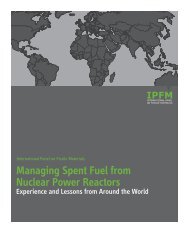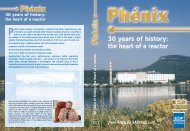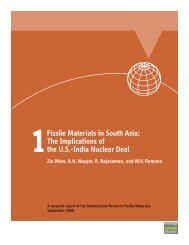Nuclear Proliferation TechnologyTrends Analysis - International ...
Nuclear Proliferation TechnologyTrends Analysis - International ...
Nuclear Proliferation TechnologyTrends Analysis - International ...
Create successful ePaper yourself
Turn your PDF publications into a flip-book with our unique Google optimized e-Paper software.
PNNL -14480<br />
3.2.5.2 Electric power control<br />
Centrifuges rotate at a very high, precise speed; therefore, control of the frequency of<br />
rotation is very important. Important elements include:<br />
`<br />
• Frequency converters<br />
• SCADA systems<br />
• Stable off-site power supplies<br />
• Very stable electric power grid<br />
3.2.5.1 Fluorine related equipment<br />
As with gaseous diffusion facilities, fluorine related equipment is necessary. These<br />
include:<br />
• Feed autoclaves used for passing UF 6 to the centrifuge cascades<br />
• Desublimers (or cold traps) used to remove UF 6 from the cascades<br />
• Product and tails stations used for passing UF 6 into containers<br />
3.3 ELECTROMAGENTIC ISOTOPE SEPARTION TECHNOLOGY HISTORY<br />
3.3.1 Technology Description<br />
3.3.1.1 Origin<br />
The process of electromagnetic isotope separation (EMIS) was developed in the United<br />
States as a part of the Manhattan project. Starting in 1941 and using already existing<br />
cyclotrons to demonstrate the technology, the U.S. decided to build bigger machines<br />
called “calutrons” to produce enriched uranium. Calutrons produced the first HEU, using<br />
slightly enriched uranium from other processes as feed. When the first gaseous diffusion<br />
plant began operating effectively, the use of calutrons for enriching uranium ceased.<br />
They are, however, still being used for other isotopic separation tasks.<br />
3.3.1.2 Basic theory<br />
The EMIS approach is based on the physical principal that ions of the same energy but of<br />
different masses describe different trajectories in a magnetic field. In particular, the<br />
trajectory of 238 U will have a larger diameter than that of 235 U. The different diameters<br />
allow for separation and collection of the material in receivers or “collection pockets”.<br />
EMIS is a batch process that produces weapons grade HEU from natural uranium in only<br />
two steps. However, hundreds to thousands of units would be required to produce large<br />
quantities of HEU due to the process’s relatively low product collection rate and the long<br />
cycle time required to recover material between runs.<br />
In the uranium EMIS process, uranium ions are generated within an evacuated enclosure<br />
(called a “tank”) located in a strong magnetic field. For the EMIS ion source, solid<br />
34



